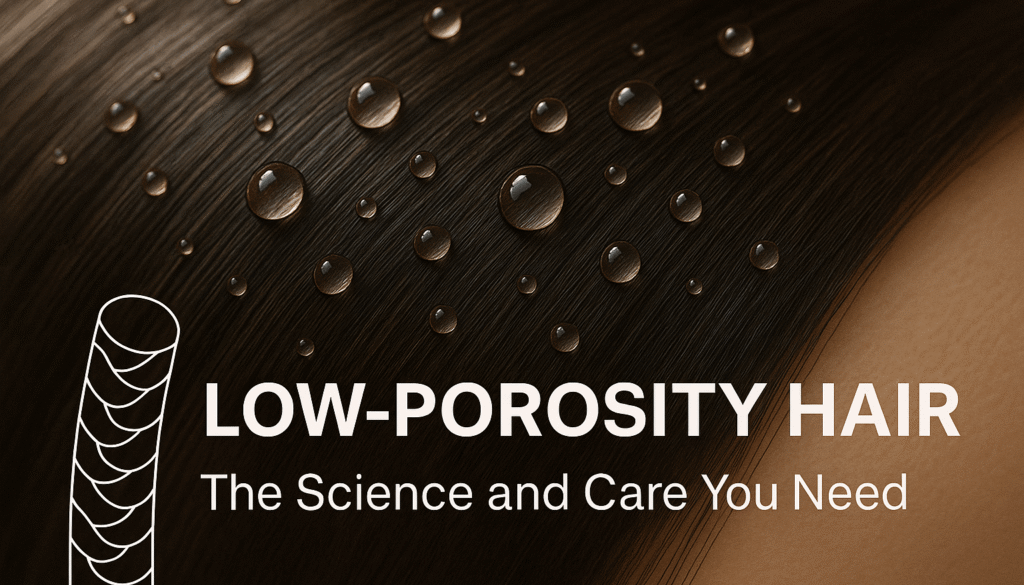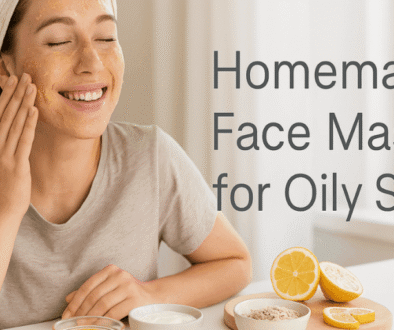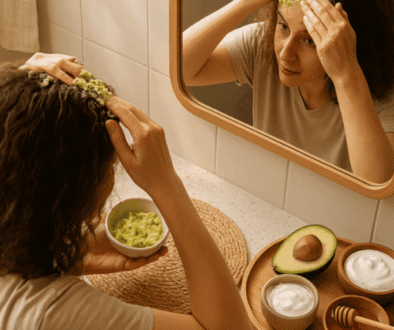Low Porosity Hair: The Science and Care You Need
True Nature Care 🌿 Home Remedies & DIY, 💇♀️ Hair care routines & remedies 0
What is Hair Porosity?
Hair porosity is a measure of how easily your hair absorbs and holds moisture and products. Normal hair quickly soaks in water – for example, up to 75% of its moisture capacity within a few minutes – then releases excess moisture as it dries. By contrast, low-porosity hair resists water. Its surface cuticle (outer layer) lies very flat and tightly sealed, so water tends to bead up and roll off rather than penetrating. In fact, one review notes that low-porosity hair “is more resistant to absorbing water and other substances,” meaning it absorbs moisture slowly and holds on to what it does absorb. This gives low-porosity hair a smooth, often stiff feel and makes hydration a special challenge. Understanding the hair’s structure and chemistry helps explain these behaviors and guides how to care for it.
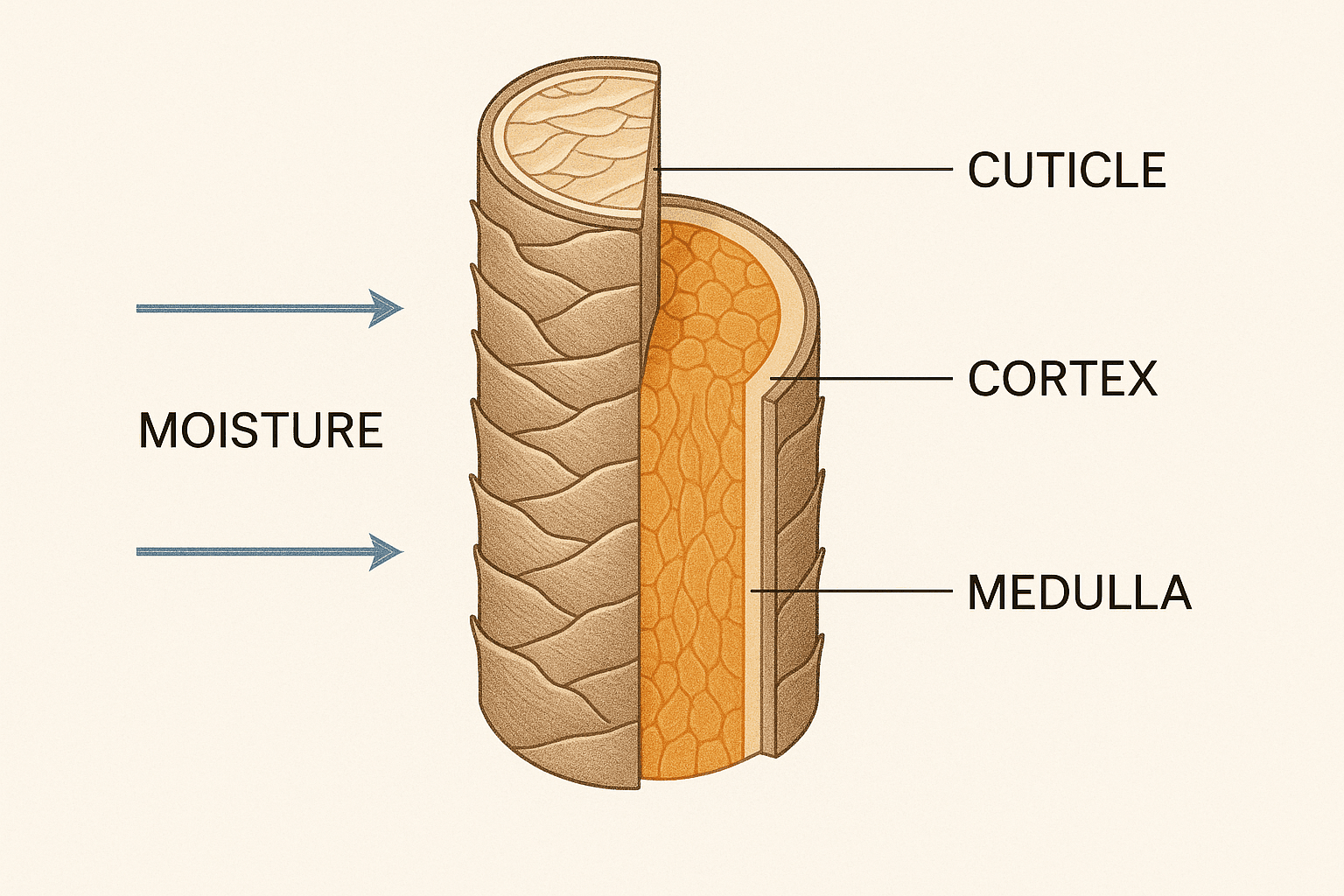
Table of Contents
ToggleHair’s Shaft Structure: Cuticle, Cortex, and Medulla
Human hair is essentially a protein fiber made of three main parts. The cuticle is the outer layer: a sheath of overlapping, scale-like cells that protect the inner fiber. In healthy hair, these cuticle cells overlap like shingles on a roof, creating a strong barrier against moisture loss and damage. Below the cuticle lies the cortex, which makes up most of the hair’s bulk. The cortex is packed with long keratin protein filaments and keratin-associated proteins that give hair its strength and elasticity. (Some very thick hairs also have a medulla – a central, air-filled core – but it does not play a major role in moisture absorption.)
In low-porosity hair, the cuticle scales are especially flat and tightly sealed. The surface is also coated with a thin layer of fatty acids (chiefly 18-methyleicosanoic acid, or 18-MEA) that hair naturally produces. This lipid layer makes the hair surface hydrophobic – it repels water. In untreated hair, this lipid coat is intact, reinforcing the closed cuticle scales and helping the hair shed water. Only when these barriers are lifted or removed (for example by strong alkaline chemicals) does water penetrate more easily.
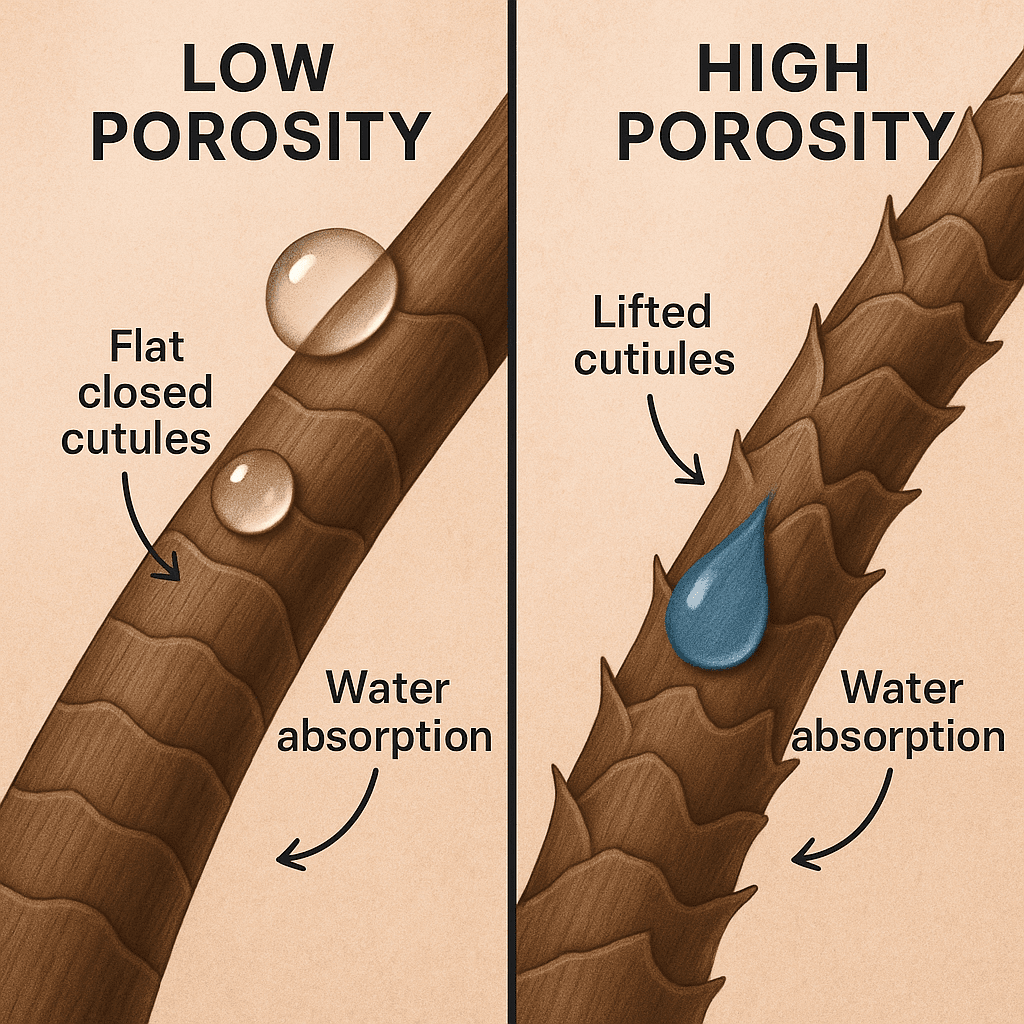
The Role of 18-MEA: Hair’s Natural Waterproofing Layer
Hair’s natural lipid coat is crucial for porosity. The surface of each cuticle cell bears 18-MEA, a fatty acid that is chemically bonded to the protein. This lipid layer acts like a waxy shield. Removing it – for instance through bleaching or relaxing (which use high pH) – makes hair more hydrophilic (water-attracting) and causes the cuticle to lift. Jones and Rivett explain that when the covalently linked fatty acids are stripped off, the hair fiber loses its hydrophobic barrier, rendering the hair surface much more porous. In practice, this means that virgin low-porosity hair (with 18-MEA intact) naturally repels water, while highly processed hair has a higher porosity because its lipids have been removed.
The hydrophobic 18-MEA layer also reduces friction between hairs and contributes to hair’s “slick” feel. If this layer is lost, hair can seem drier and more prone to static or frizz (especially in humidity) because water can more easily penetrate the cortex. In short, intact 18-MEA + flat cuticles = low porosity (waterproof hair); stripped 18-MEA + raised cuticles = high porosity (water easily absorbed).
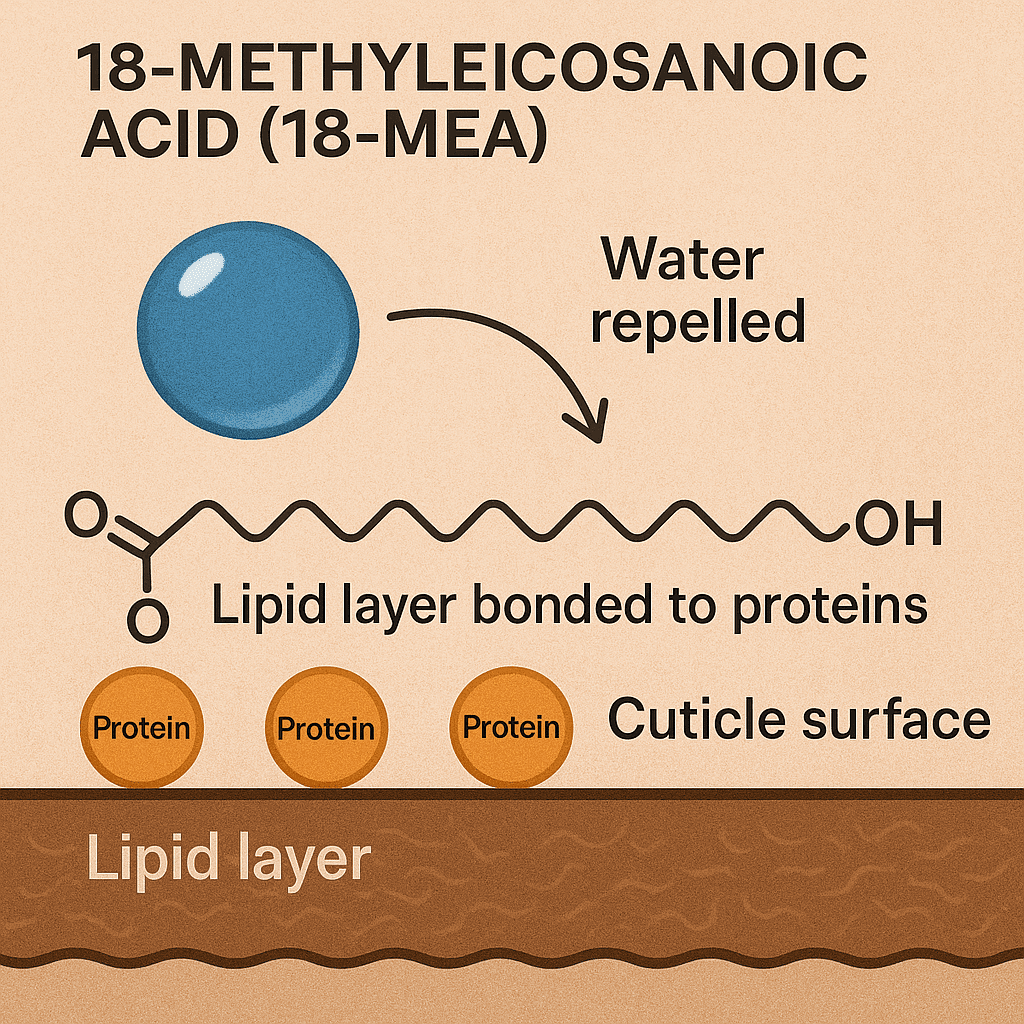
How pH Affects Hair Porosity and Cuticle Behavior
Another key factor in hair porosity is pH. Hair proteins contain acidic and basic side groups that form salt bridges (electrostatic bonds) in neutral or mildly acidic conditions. These salt links help hold the protein structure together. At low pH (acidic), extra hydrogen ions bind to the protein and break some of these salt bonds, causing the hair fibers to contract and the cuticle to tighten. At very low pH (around 3–4), hair absorbs significantly less water and its diameter actually decreases – it becomes “shrunk” and feels hard. In contrast, at high pH (alkaline conditions), salt bonds break differently and the hair fiber swells. For example, a study found that hair equilibrated at pH 10 took up much more water and grew fatter in diameter than hair at pH 5, while hair at pH 3 absorbed the least water. In practical terms: alkaline conditions open the cuticle, making hair more porous and easier to hydrate (but also more vulnerable), while acidic conditions flatten the cuticle, tightening the strand.
This explains why many conditioning rituals use acid: a gentle vinegar or lemon rinse (pH ~3–5) after shampooing will cause the hair fiber to contract and the cuticles to lie very flat, leaving the strand smoother and shinier. Conversely, alkaline treatments (like bleach or relaxers) deliberately lift the cuticle and remove lipids to allow dye or chemicals to penetrate. By understanding pH, you can use products to first open and then close the cuticle at will.
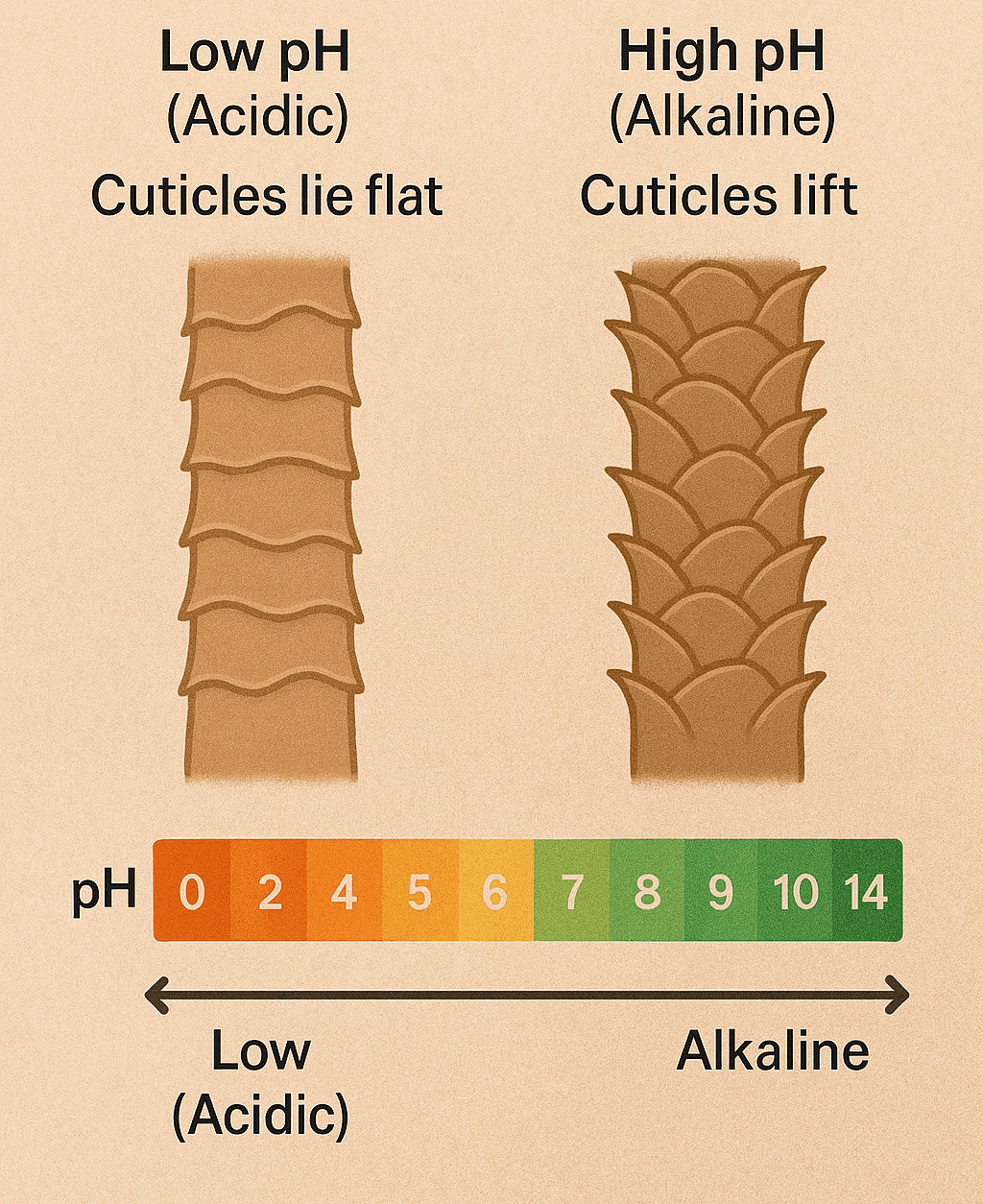
How Low-Porosity Hair Absorbs Water (and Why It Feels Dry)
When hair gets wet, it usually swells more in thickness than in length — up to 15% wider but only about 2% longer. That’s because water soaks into the inner cortex and pushes the strand outward, lifting the cuticle scales slightly and making hair feel rougher. But low-porosity hair works differently.
Because its cuticles lie flat and are coated with a natural fatty layer, water has a tough time getting in. Instead of soaking up moisture, low-porosity hair often lets water bead up and roll right off. Even in humid weather, the cuticle scales barely lift unless exposed to heat or long soaking.
When moisture does finally get in, the hair may swell slightly, but it stays fairly rigid. And since the same sealed cuticles also slow down evaporation, water tends to get “stuck” inside. This can make your hair feel heavy or damp on the outside — even though it’s still dry deep down.
Here’s why that matters: wet hair is more flexible than dry hair. So when you heat-style or blow-dry it, the shape sets as it dries. But if water gets in later (from humidity or mist), the hair softens again and your style can fall flat. Low-porosity hair tends to hold styles well at first — but once it finally absorbs moisture, it can go limp fast.
Bottom line? Low-porosity hair absorbs and releases water slowly. That’s why it often feels dry, holds styles well — and then suddenly loses them when it finally gets wet.
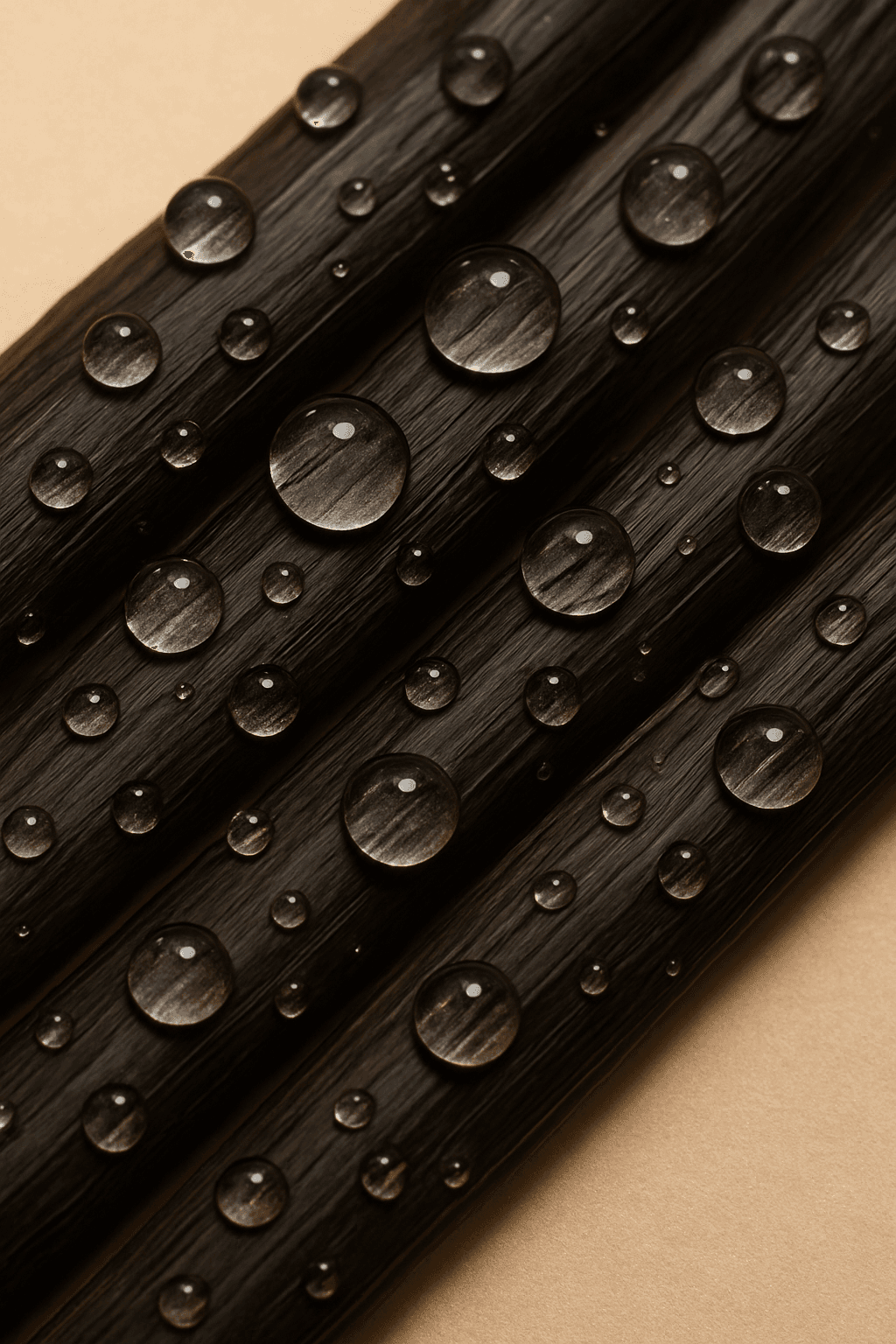
Science-Backed Tips for Low Porosity Hair Care
Knowing the science of low porosity hair suggests clear strategies for care. Here are the most important, research-supported tips:
Balance pH – Open then Seal the Cuticle.
Start with a gentle, slightly alkaline or clarifying shampoo to lift the cuticle scales and remove buildup. This could be a mild clarifier or a shampoo with pH closer to neutral. Then apply conditioner or treatments while the cuticle is raised. Finally, rinse your hair with cool water or a diluted acidic rinse (apple cider vinegar or lemon water at pH ~4–5) to clamp the cuticle down. Studies show that hair at pH 10 absorbs more water, while at pH 3 it absorbs almost none, so manipulating pH with products is key. For example, after a warm deep-condition (which opens the cuticle), a final vinegar rinse helps close and smooth the scales.
Clarify Regularly, But Gently.
Low-porosity hair often accumulates product on its surface because nothing soaks in easily. Use a gentle clarifying shampoo or a cleanser with a chelating agent once in a while (not every wash, to avoid drying out hair) to remove mineral and product buildup. This clears the way so moisturizers can actually reach the hair fiber. Always follow a clarifying wash with a good conditioner to replenish moisture. The Medical News Today review emphasizes using “low-residue” products for low-porosity hair, meaning formulations that won’t coat the hair too heavily.
Use Humectants Thoughtfully.
Humectant ingredients like glycerin, honey, panthenol (provitamin B5), and aloe vera can attract and hold water in your hair shaft. These are often included in conditioners and leave-ins for low-porosity hair. For example, a leave-in spray with glycerin or honey can help draw moisture into the hair, especially in humid weather. (A Medical News Today article lists glycerin and honey as key humectants for low-porosity hair.) However, use them judiciously: in very dry climates, humectants can actually pull water out of your hair and make it feel dry. Always balance a humectant with a bit of oil or cream to lock moisture in.
Seal with Lightweight Oils, Not Butters.
After conditioning, lock in moisture with a few drops of a lightweight oil like fractionated coconut, grapeseed, or jojoba oil. These oils have smaller molecules that can slightly penetrate the hair, but mostly they sit on the surface to prevent moisture loss.
Remember, oils don’t hydrate—they just seal in existing moisture. Even coconut oil, known for its penetration, can’t moisturize on its own. Use it sparingly after conditioner, especially before heat styling or sun exposure.
Avoid heavy butters and silicones (like shea butter or thick creams). These can coat low-porosity hair, leading to buildup, stiffness, and blocked moisture entry.
Tip: Less is more. A light touch goes a long way in keeping your hair soft, sealed, and breathable.
Don’t Overload with Protein.
Protein treatments can be helpful for very damaged hair, but on healthy low-porosity hair they often do more harm than good. Protein molecules bind tightly to hair, filling small gaps, but if the cuticles are sealed, they mostly sit on the outside. Cosmetic experts note that protein masks “do not absorb well into low porosity hair… build up on the hair’s surface, making it stiff and reducing how much moisture can get in”. Overuse of protein can leave low-porosity hair feeling straw-like and brittle. Instead, focus on moisture: alternate any protein treatment with a rich deep conditioner or moisturizing mask. If your hair has been heavily processed or feels mushy, a little protein can temporarily strengthen it, but in general prioritize hydration over protein for low-porosity strands.
Use Gentle Heat Wisely.
Warmth helps open the cuticle to let moisture in. During deep conditioning, try using a hot towel, shower cap, or hair steamer to gently heat your hair. Professional stylists recommend steam or warm heat because it “relaxes the cuticle, allowing water vapor to penetrate” the hair shaft. After leaving a conditioner on with heat, a final cool rinse will then firm up the cuticles around that moisture. (Note: this is mild heat during treatment – avoid excessive blow dryer or flat iron heat, as that can strip natural oils and damage the hair.) In summary, a warm moisture treatment + cool seal method is proven to make low-porosity hair more absorbent.
Adjust Your Routine: Smaller, Frequent Steps.
Patience is important. Low-porosity hair usually needs longer contact time with products. Instead of applying a ton of product at once, try lighter applications more frequently. For example, apply a small amount of conditioner and let it sit under a shower cap for a few extra minutes to “soak in.” Some people like to rinse hair and then re-wet and re-condition in sections. Also, keep hair covered (with a cap or steamer) while conditioning to trap heat and moisture. The idea is to give treatments more time to work under the closed cuticle rather than piling on layers of product. Overloading with product not only wastes it (it just sits on the outside) but can actually weigh hair down.
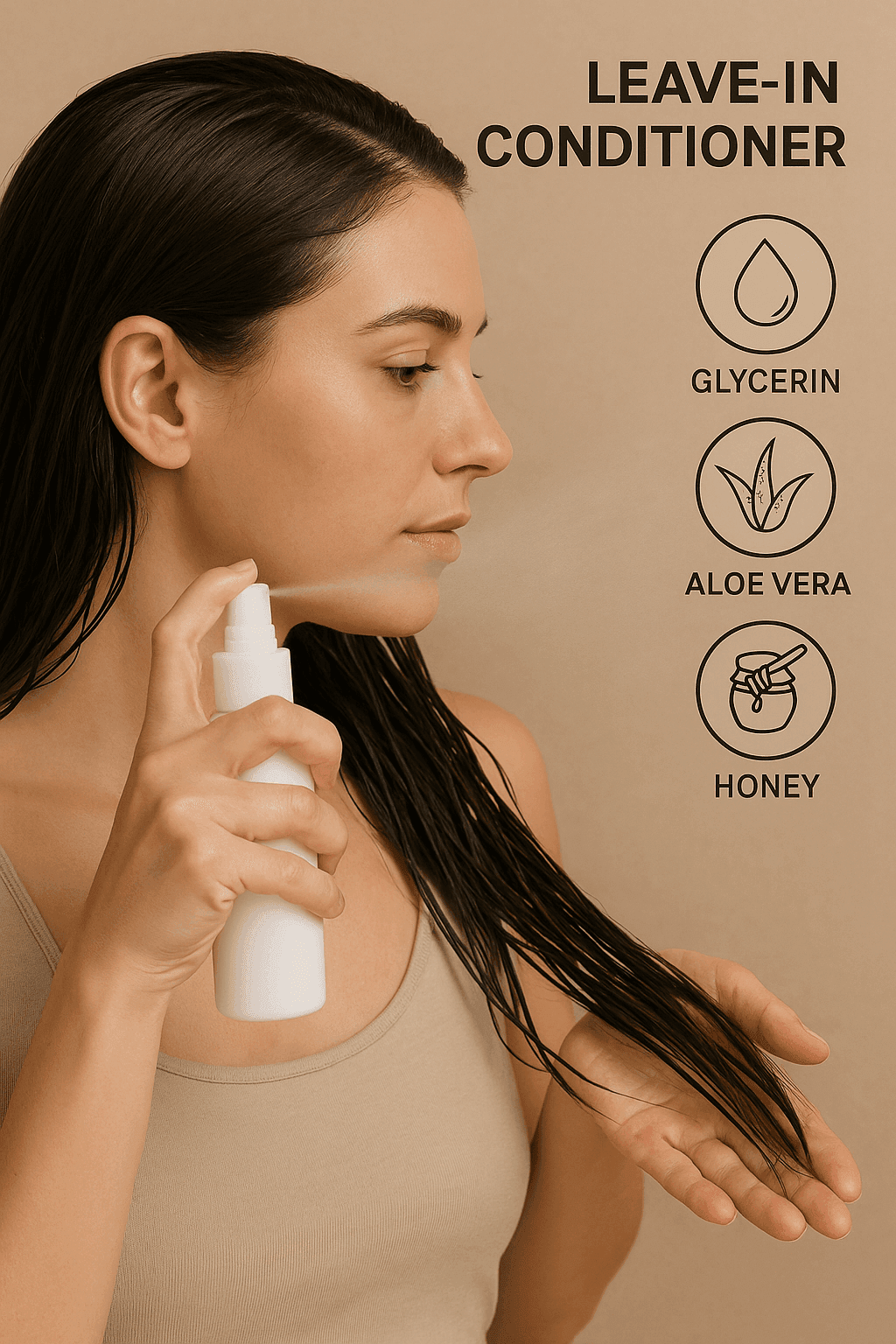
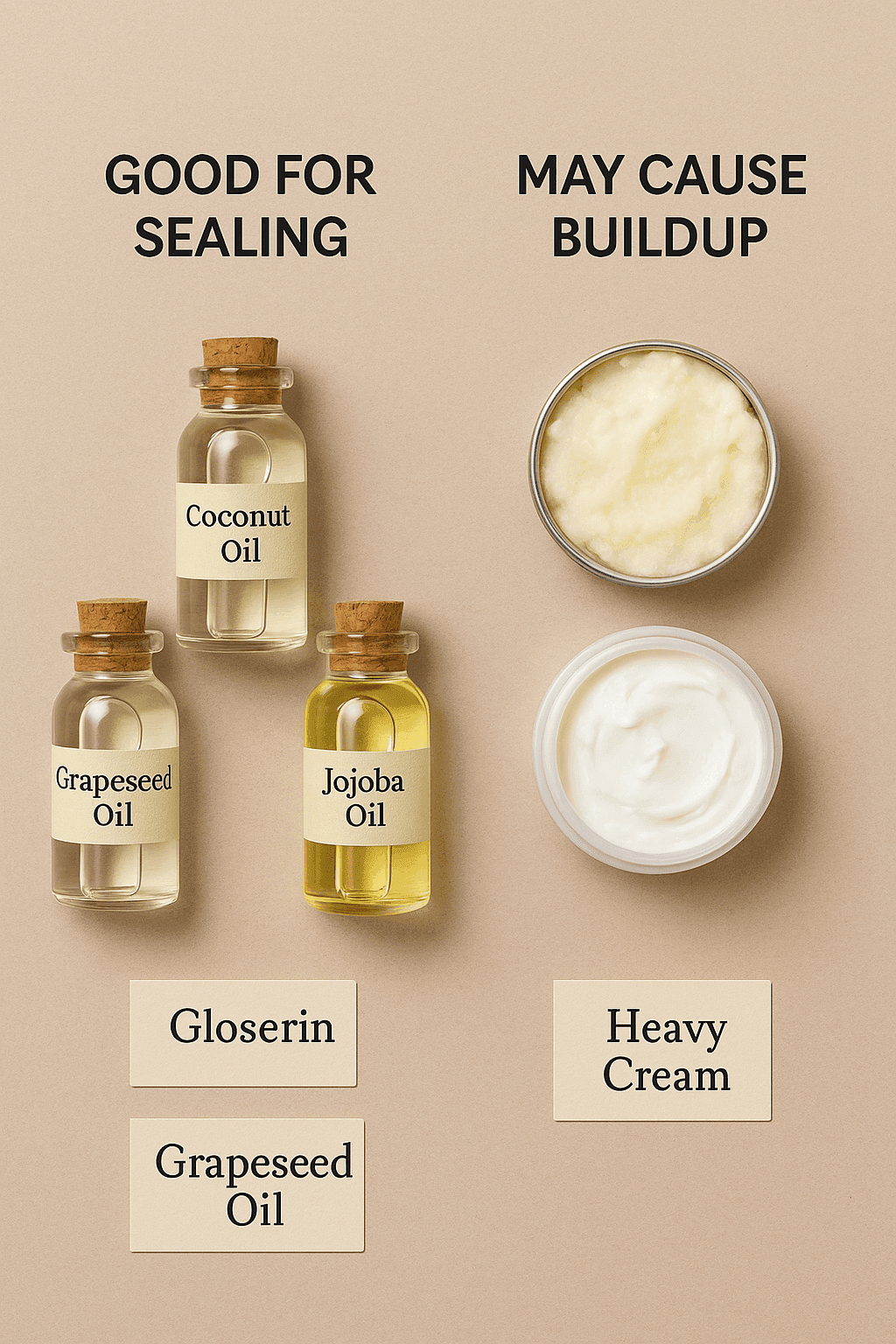
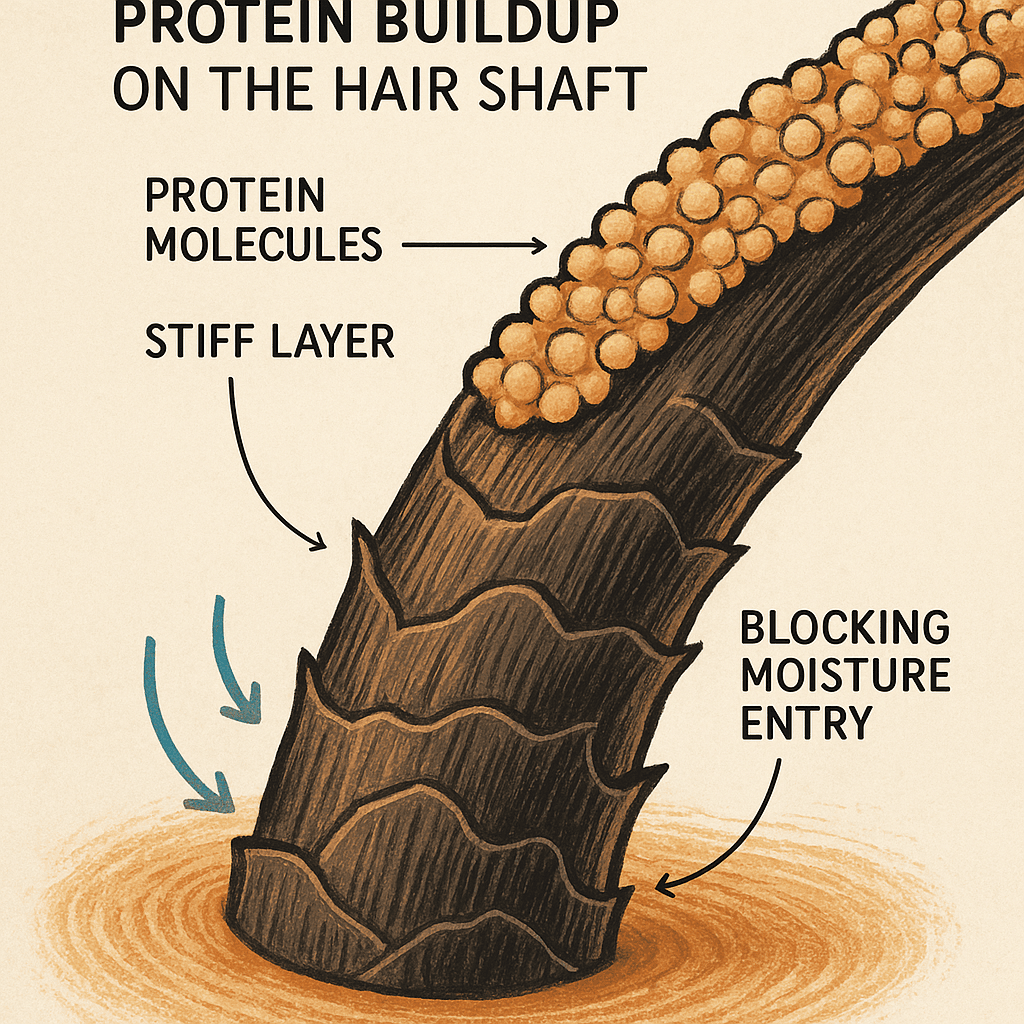
In short, low-porosity hair needs strategies to coax moisture in. By opening the cuticle (heat or alkaline wash), using humectants to draw in water, and then sealing the cuticle (cool acidic rinse and a light oil), you can hydrate your strands more effectively. It’s also key to avoid ingredients that just sit on the surface (heavy oils, butters, protein overload). As one authoritative review puts it, “It is not possible to make low porosity hair more absorbent in the long term. But using steam, humectants, and low-residue products can help keep the hair hydrated”. With consistent, gentle care tailored to its chemistry, low-porosity hair can stay healthy, soft, and manageable.
How To Identify Low-Porosity Hair
Test Your Hair’s Porosity (for Fun!). If you’re not sure whether your hair is low-porosity, try simple at-home tests. The classic float test involves dropping a clean strand of hair into water: if it floats for a while before slowly sinking, it’s likely low-porosity (because it repels water). Another method is the spray test: spray water on a dry strand – if water beads up or rolls off, that indicates low porosity. (High-porosity hair absorbs water quickly with no beads.)
Key Tips (Summary):
- Balance pH: Clarify with a mild shampoo to lift cuticles, apply conditioner, then rinse with cool dilute vinegar or lemon water (pH ~4–5) to seal them.
- Clarify Lightly: Use a gentle clarifying or low-residue shampoo once in a while to remove product buildup, and always follow with a moisturizing conditioner.
- Moisturize Smart: Use products with humectants (glycerin, honey, aloe) to draw in moisture, especially in humid weather, but avoid using them alone in very dry climates.
- Seal Carefully: After hydrating, apply a small amount of light oil (like fractionated coconut or argan) to lock in moisture. Avoid thick butters or heavy silicones that coat and block hair.
- Moderate Protein: Don’t overdo protein treatments on low-porosity hair – too much protein can build up and cause stiffness. Focus on hydration and use protein only occasionally.
- Use Heat:* Incorporate gentle heat (steam, warm towel, heat cap) during conditioning to relax the cuticle. Finish with a cool rinse to re-flatten the scales.
- Be Patient: Low-porosity hair takes time to absorb products. Use smaller amounts of product and give them time (e.g. deep condition under a cap) rather than piling on a lot at once.
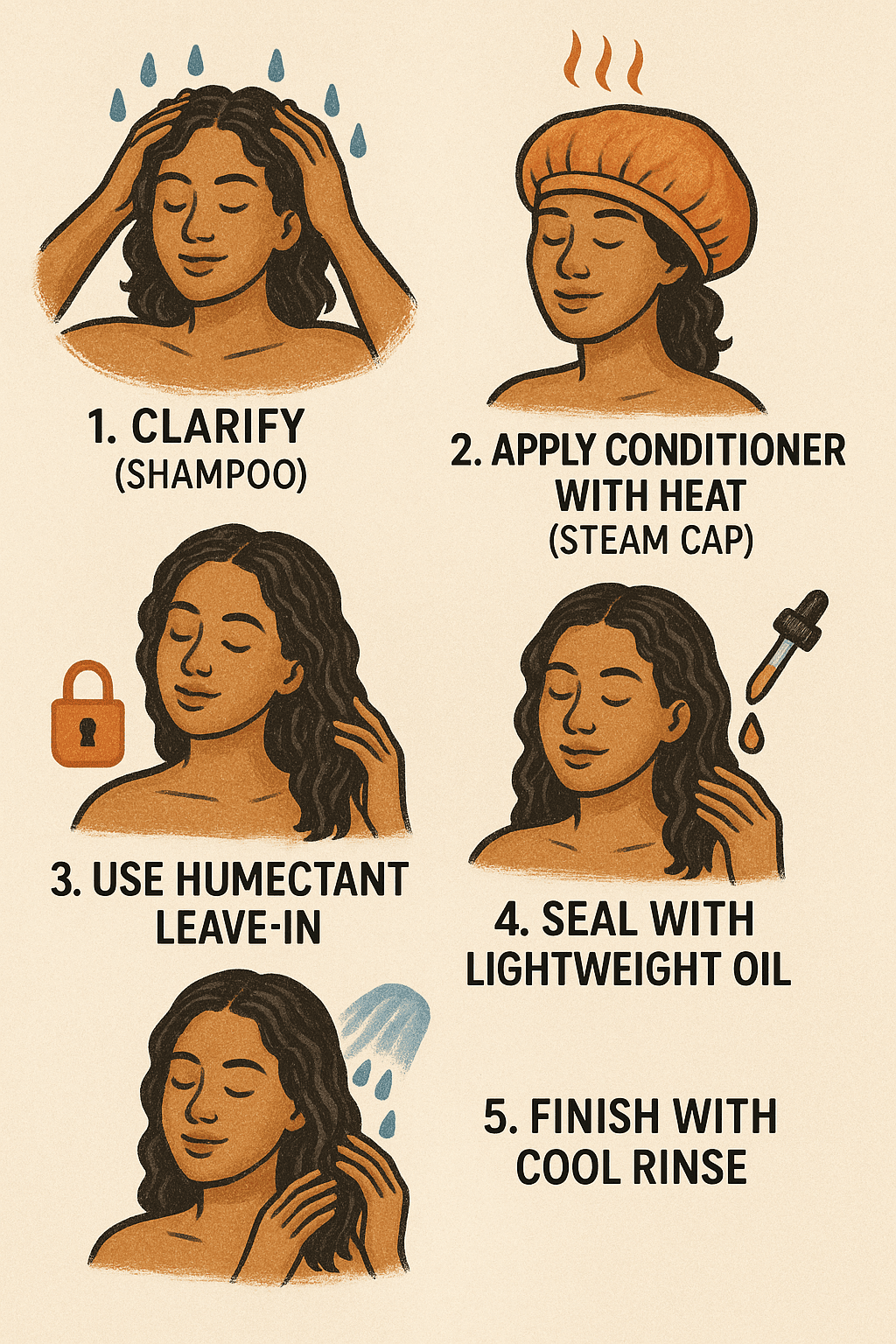
Conclusion
Low‑porosity hair resists water because its cuticles lie flat and are coated in a natural lipid barrier, so moisture and products tend to sit on the surface rather than absorb. To care for it, you need to gently lift the cuticle (with mild cleansing, heat, or pH adjustments), draw water in with humectants, then seal it with lightweight oils—all while avoiding heavy build‑up or too much protein. Proper testing at home (float, spray, buildup) helps you confirm your porosity type before choosing the right routine.
Frequently Asked Questions
1. How can I tell if I have low-porosity hair?
Do an at‑home porosity test:
Float Test: Drop a clean, dry strand into room‑temp water. If it floats for 30 + seconds, it’s likely low porosity (the cuticle repels water)
Spray Test: Mist a dry section—if droplets bead up on the surface instead of soaking in, that’s a low‑porosity sign
Buildup Test: Notice if products sit on your hair and make it feel coated after application—it often means moisture can’t penetrate. Learn how to remove buildup gently with our DIY Hair Masks for Curly Hair guide.
2. What makes low‑porosity hair different from other hair types?
Low‑porosity strands have tightly packed cuticles that lie very flat, sealed by a hydrophobic fatty‑acid layer (18‑MEA), so they naturally resist water and. By contrast, high‑porosity hair has raised or damaged cuticles that absorb (and lose) moisture quickly.
3. What are the key characteristics of low‑porosity hair?
Slow wetting & drying: Hair takes longer to become fully saturated and to air‑dry
Product buildup: Oils and conditioners tend to sit on the surface, making hair feel greasy without real hydration
Shiny & smooth look: Flat cuticles reflect light well, giving strands a sleek appearance .
Chemical resistance: Dyes and treatments often take longer or require stronger formulas to penetrate.
4. What are the pros and cons of low‑porosity hair?
Pros:
- Excellent moisture retention: Once water gets in, it stays locked due to the sealed cuticle.
- Less breakage: Strong cuticle barrier makes strands naturally more resilient.
Cons:
- Hard to hydrate: Common conditioners can sit on the surface and not really moisturize .
- Longer styling routine: You’ll need extra steps (heat, clarifying, acid rinses) to get products to penetrate.
5. Is low‑porosity hair “good” or “bad”?
Neither—it’s simply a unique hair profile that thrives on its own biology. Its tight cuticle makes it strong and shiny, but you’ll need targeted care (clarifiers, humectants, heat, light sealants) to keep it soft and manageable.
6. What’s the most effective way to moisturize low‑porosity hair?
- Clarify gently with a mild shampoo or chelating cleanser to lift cuticles and remove buildup.
- Apply humectants (glycerin, honey, aloe vera) in your conditioner or leave‑in to draw moisture into the cortex.
- Use gentle heat (steamer, warm towel, shower steam) during conditioning to relax the cuticle.
- Seal with light oil (fractionated coconut, grapeseed, jojoba) to lock moisture in without heavy buildup.
- Finish with a cool acidic rinse (diluted vinegar or lemon water, pH 4–5) to clamp the cuticle down and smooth the shaft.
7. Why does my low‑porosity hair feel dry even after applying products?
When cuticles stay sealed, creams and oils just sit on the surface rather than absorbing—so you get the feeling of moisture without the actual hydration. Regular clarifying and using heat or pH‑adjusted rinses helps products penetrate rather than layer up.
8. What are the best oils for low‑porosity hair?
Choose small‑molecule, lightweight oils that can actually penetrate slightly and then seal moisture:
- Fractionated coconut oil
- Grapeseed oil
- Jojoba oilThese sit lightly on the surface to lock in moisture without coating the cuticle too heavily.
9. Why do protein treatments make low‑porosity hair feel stiff?
Protein molecules are relatively large and don’t absorb well into sealed cuticles, so they build up on the surface, causing stiffness and reduced flexibility. Use protein masks sparingly, alternating with rich moisture treatments.
10. How often should I wash low‑porosity hair?
- Shampooing: 1× per week with a gentle or clarifying formula to remove buildup without stripping natural oils.
- Clarifying: Every 2–3 weeks (or sooner if products feel coating) to keep the cuticle ready to absorb moisture .
11. What ingredients should I avoid on low‑porosity hair?
- Heavy butters (shea, cocoa) and thick silicones that coat and block moisture entry.
- Excessive protein (over‑strengthening masks) that builds up on the surface and causes brittleness.
- High‑mineral hard water, which can leave deposits on the hair—consider a chelating shampoo if you have hard water at home.
References: Check It Out
Costa, C., Gomes, A. C., Matamá, T., & Cavaco-Paulo, A. (2016). Human hair and the impact of cosmetic procedures: A review on cleansing and shape-modulating cosmetics. Cosmetics, 3(3), 26. https://doi.org/10.3390/cosmetics3030026
Jones, L. N., & Rivett, D. E. (1997). The role of 18-methyleicosanoic acid in the structure and formation of mammalian hair fibres. Micron, 28(6), 469–485. https://doi.org/10.1016/S0968-4328(97)00039-5
Malinauskyte, E., Cornwell, P. A., Reay, L., Shaw, N., & Petkov, J. (2020). Effect of equilibrium pH on the structure and properties of bleach-damaged human hair fibers. Biopolymers, 111(11), e23401. https://doi.org/10.1002/bip.23401
Rele, A. S., & Mohile, R. B. (2003). Effect of mineral oil, sunflower oil, and coconut oil on prevention of hair damage. Journal of Cosmetic Science, 54(2), 175–192.
West, M. (2023, November 29). Low porosity hair: What it is, characteristics, and care. Medical News Today. https://www.medicalnewstoday.com/articles/low-porosity-hair
